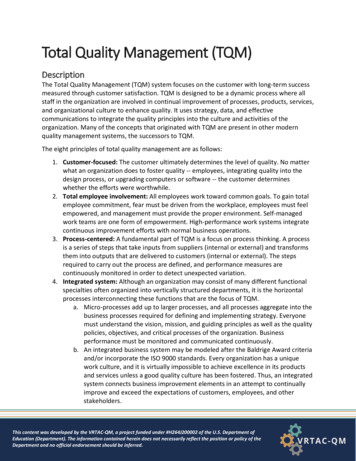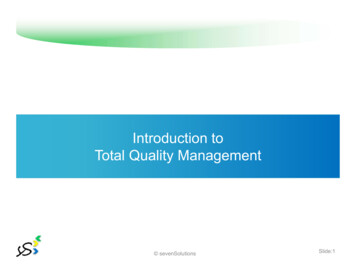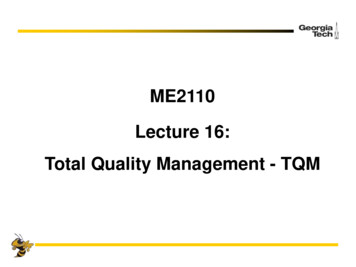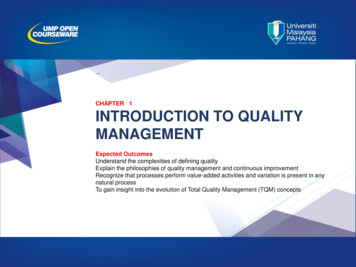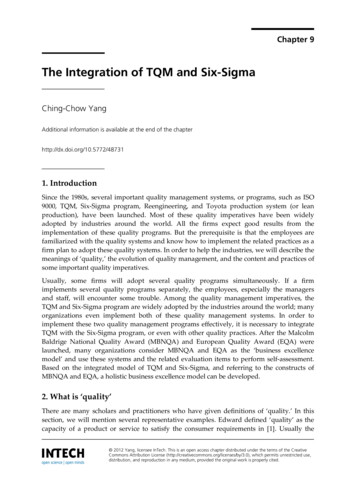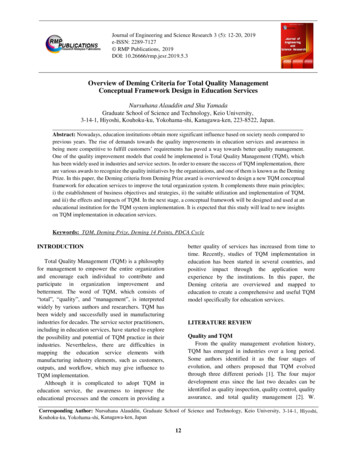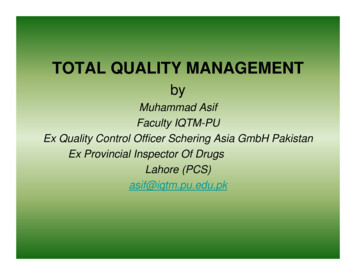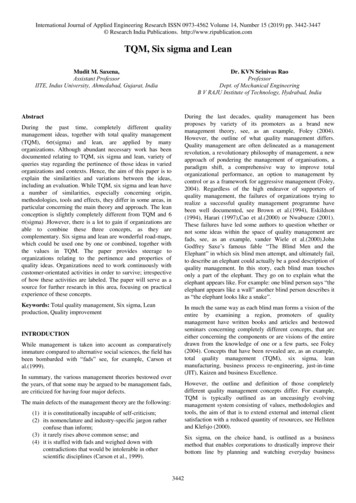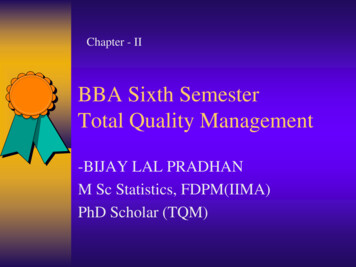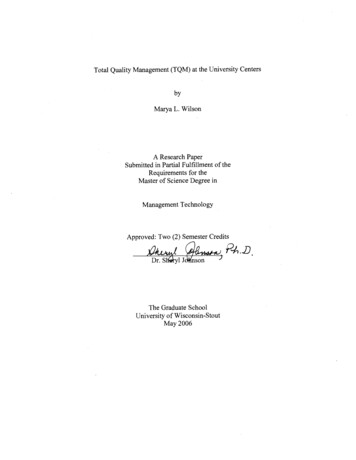
Transcription
Total Quality Management (TQM) at the University CentersbyMarya L. WilsonA Research PaperSubmitted in Partial Fulfillment of theRequirements for theMaster of Science Degree inManagement TechnologyApproved: Two (2) Semester CreditsThe Graduate SchoolUniversity of Wisconsin-StoutMay 2006
The Graduate SchoolUniversity of Wisconsin StoutMenomonie, WI 5475 1ABSTRACT i l s o nMarya,L.(Writer) (Last Name)(First Name)(Middle Initial)Total Quality Management (TQM) at the University Centers(Title)Management Technology(Graduate Program)Dr. Sheryl Johnson(Research Advisor)May 2006(Month Year)47(# of Pages)American Psychological Association, 5thedition(Name of Style Manual Used in this Study)The University Centers is looking for a quality management system that willensure the highest level of customer service while providing a process that allows foremployee participation with high levels of enthusiasm by the staff. Through TQM, theUniversity Centers will show an increase of participation in their quality managementsystem while improving morale for quality systems and improvement through training ofbasic quality management systems.The University Centers started with an I S 0 9000:2000 quality systemimplementation and moved into a TQM based quality management system with the hopesof a more positive experience.
The literature review provided an informational background on quality systems,TQM history, benefits, and negatives, and I S 0 9000 history, benefits, and negatives. Thegoal of the literature review is to provide a well rounded discussion and review of qualitysystems in general and two programs used worldwide with success and failure.The data collected did not reveal a higher level of participation in continuousimprovement projects but did find some benefits of both the IS0 9000 and TQM qualitysystems. It also did not ensure higher levels of customer service. The results, however,did show that the staff at the University Centers would like to participate and improveprofessional training and development, implement stronger measures, goals, andobjectives, and implement a usable continuous improvement program. These areas ofimprovement all fall in line with major themes and ideas of a TQM based system.
AcknowledgmentsThis project has been very near and dear to my heart. I look forward to how theresults of this process will be used and the benefits this study will bring to UniversityCenters. Because this project was a success and my masters program is completed, I needto give thanks for all of those who helped in this wonderful journey.I want to thank God for without him, nothing is possible.I want to especially thank my parents Jeff and Joy Buchanan. Their support, love,care, and constant help are more than anyone could ask for. I could not have done thisproject or finished my masters degree without their help. I am proud to be their daughter.I would like to thank Bill Siedlecki and the staff at University Centers forallowing me to come in, take this crazy idea, and see where it would lead. The support,enthusiasm, and level of work that come out of Bill and his staff are second to none.I want to thank Sherri Johnson for being a wonderful advisor. She truly providedamazing guidance through this process. Her support, honesty, and humor made thisproject one that was much more endurable than I could have imagined.Last but not least, I am so very lucky to be surrounded by the most wonderfulgroup of friends. All of them have given me support, love, courage, and lots of humorthrough this journey of earning a masters degree. Without them, I know I would not havebeen able to endure decision theory, six sigma, and a literature review. I wish I couldname them all but there are a few who deserve mention: Jae, Ann, Tracy, Stephanie, Paul,Beth and John, Chris and Cathy, Evy, Renee7 and Larry, Clare, Rebecca, Dan and Mary,Syrnantha, Angela, Erinn, and so many others. I thank you from the bottom of my heart.
TABLE OF CONTENTS.PageCHAPTER ONE: INTRODUCTION.1Statement of the Problem .23Purpose of the Study .Assumptions of the Study .3Definition of Terms .4Limitations of the Study .5Methodology .5CHAPTER TWO: LITERATURE REVIEW . 6Introduction .6TQM Introduction .7IS0 9000 .9History .910Benefits of I S 0 9000 .Negatives of IS0 9000 . 12TQM .1414History .15Benefits of TQM .;16Negatives of TQM .
CHAPTER THREE: METHODOLOGY .1919Introduction .Case Study Approach .19Research Design and Analysis .20Population and Sample .21CHAPTER FOUR: RESULTS AND FINDINGS . 22Question One .22Past Practices .25Current Practices .Question Two .Future Practices - Question Three .27Trends - Question Four .2931Quality Management Systems - Question Five .Non-conforming Database - Customer Satisfaction and Employee Participation . 33CHAPTER FIVE: CONCLUSION .37Limitations .37Summary .37Recommendations . 38Recommendations for Future Research .4244References .Appendix One - Interview Questions .47Figure One - Non-conforming Database Information .35
Chapter IIntroductionMehra, Hoffman, and Sirias (2001) state that the 1980's showed companies takinga serious look at the quality revolution and how to use it to attempt to bring aboutprofitability, market share, and improvement. In that time, they explain there was noquestioning of results that were achieved by quality systems and using any type of qualitytechnique. As well, Mehra et al. (2001) goes on to explain, that persons, organizations,companies, etc. did not question the quality systems being used. "All qualityimprovement efforts were supposed to end in good results and nothing was expected togo wrong." (Mehra et al., 2001).Total quality management started with Deming. (ASQ, 2006). With hisrevolutionary works in Japan in the 19507s,total quality management became a popularquality system. In 1987, IS0 was first published and widely used as the internationalstandard for quality management (ISO, 2006). Organizations of all types were using thissystem and continue to do so today. There are many types of quality managementsystems such as lean, six sigma, TQM, IS0 9000, Malcolm Baldrige (ASQ, 2004). Thekey to choosing the correct system that is best for your organization is not a small taskand one that should be reviewed thoroughly (Mehra et al., 2001).The Memorial Student Center at the University of Wisconsin-Stout houses theUniversity Centers which are responsible for the management of University Recreation,Leadership and Involvement Centers, and the Service Center. General operations areincluded for the basic functions of a business. This group plays a vital role in providingsafe, fun, and enjoyable activities and services for its students, staff, and faculty. The
student center and University Centers are the center of information, recreation,entertainment, and assistance for UW-Stout students, faculty, staff, and the surroundingcommunity.A consultant was hired and the implementation of an I S 0 9000 qualitymanagement system was started. They completed a full implementation by June 2004.While a compliant I S 0 9000 system is in place, the perception of the employeesworking at University Centers shows that basic processes are either by-passed or not usedat all. Based on informal employee responses, the system is not looked upon with thehighest of respect or enthusiasm. The system was set up for what is normally amanufacturing environment making it quite difficult for a service team to use andembrace.The University Centers in the past, with the endorsement of the university, hasutilized Deming's Total Quality Management System. This group has chosen to use thisplatform in hopes of gaining a larger level of participation from its students and staff.Statement of the ProblemThe Total Quality Management (TQM) based quality system is the program thatbest applies to this organization because it will allow freedom of expression inimprovement processes. The TQM quality system will replace the current I S 0 9001 :2000quality system. The TQM process has a human element to it that other quality systems donot have. TQM will ensure a larger participation level from this organization and helpincrease morale of the employees working with this particular system.
Purpose of the StudyThe University Centers is looking for a quality management system that willensure the highest level of customer service while providing a process that allows foremployee participation with high levels of enthusiasm by the staff. Through TQM, theUniversity Centers will show an increase of participation in their quality managementsystem while improving morale for quality systems and improvement through training ofbasic quality management systems.Assumptions of the StudyAll employees are knowledgeable of IS0 9000 and TQM quality systems.All employees at the University Centers are familiar with basic customer serviceskills.Participants in interviews will be truthful and honest and will find the interviewsvaluable.
Definition of TermsDocumentationInformation and its supporting medium. Examples include records, specifications,drawings reports, work instructions, and job aids (ISO, 2000).Freedom of Expression.The ability to solve problems with an 'outside the box approach'. Deming (2000)also explains freedom of expression through point thirteen - encourage educationand self-improvement for everyone through new learning and education.Human ElementTQM is the only system that ensures the employeelteam member is made apriority in the quality system (Deming, 2000). He also describes human elementthrough his points eight - drive out fear, nine - break down barriers between staffareas, and twelve - remove barriers that rob people of pride of workmanship.I S 0 9000A set of standards that describe fundamentals of quality management systems andspecifies the terminology for quality management systems (ASQ, 2000).Non-Conforming or non-conformityThe non-fulfillment of a specified requirement (ASQ, 2000).Participation (total employee involvement)Following the processes, documenting action requests, communication aboutimprovements, and involvement in training and development (Deming, 2000).
ProcedureThe steps in a process and how these steps are to be performed for the process tofulfill customer's requirements (ASQ, 2000).Quality Management System (QMS)Management system to direct and control an organization with regard to quality(ASQ, 2000).Total Quality ManagementAll members of an organization participate in improving processes, products,services and the culture in which they work (ASQ, 2000).Limitations of the StudyThis is a case study so only one organization is being reviewed. It will be difficultto show any type of cause-effect analysis.TQM implementation is still taking place so true results of how well the systemworks might be skewed.MethodologyThe design for this research was a qualitative research design using a case study.It was the goal of the researcher to compare and contrast the I S 0 9000 and TQM qualitymanagement systems and their use from June 2004 through May 2006.
Chapter I1Literature ReviewIntroductionQuality control or quality management has a long and distinguished (Juran, 1995)history. Quality systems started back in very primitive days with hunters learning whichtype of wood was best for making bows and arrows. Juran describes the history of qualityin this list below:Primitive ManThe Village Marketplace-LaborGrowth of CommerceRise in CraftsmanshipGuildsApprenticeshipsRise of inspectionsGovernment Involvement in QualitySafety and Health of CitizensConsumer ProtectionThe Mark or SealQuality Control ProcessThe Feedback LoopSelf Control and InspectionThe Industrial RevolutionThe Rise of Quality Assurance
TQM IntroductionQuality systems have been in existence for many more years than realized. It wasduring 1945-1951 that Dr. Juran and Dr. Edward Deming traveled to Japan to givelectures on quality control systems. (Juran, 1995).Total quality management was derived by Deming in the 1940's and implementedin Japan in the 1950's (Deming, 2000). At the time, the US was not interested in this typeof quality control. The United States Navy used statistical process control (a part ofTQM) during the 1950's and beyond. TQM was not used, however, in manufacturing orservice industries. During the early 1980's, the US started to use the terms total qualitymanagement and truly began applying Deming's 14 points as a total quality managementsystem.The methods for implementing this approach come from the teachings of suchquality leaders as Philip B. Crosby, W. Edwards Deming, Armand V. Feigenbaum, KaoruIshikawa and Joseph M. Juran (Total, 2006).A core concept in implementing TQM is Deming's 14 points, a set of managementpractices to help companies increase their quality and productivity (Deming, 2000):1. Create constancy of purpose for improving products and services.2. Adopt the new philosophy.3. Cease dependence on inspection to achieve quality.4. End the practice of awarding business on price alone; instead, minimize total costby working with a single supplier.
5. Improve constantly and forever every process for planning, production andservice.6. Institute training on the job.7. Adopt and institute leadership.8. Drive out fear.9. Break down barriers between staff areas.10. Eliminate slogans, exhortations and targets for the workforce.11. Eliminate numerical quotas for the workforce and numerical goals formanagement.12. Remove barriers that rob people of pride of workrnanship, and eliminate theannual rating or merit system.13. Institute a vigorous program of education and self-improvement for everyone.14. Put everybody in the company to work accomplishing the transformation.I S 0 9000 IntroductionThe term IS0 - International Organization for Standardization - was introduced inthe early 1980's as well and has been used so frequently since the early 1990's it createda wave of organizations wanting and needing certification to this quality managementsystem. The use of I S 0 9000 as an organizational platform has been tremendous. Thereare other system platforms that can be used but because of the knowledge and marketingof ISO, many organizations chose this platform without researching others.The majority of organizations world-wide using I S 0 9000 is phenomenal. I S 09000 is so widely known that many customers require their vendors to be at a minimumcompliant with this quality management system or at a maximum certified to this system.
It is becoming harder and harder for organizations to compete without some type ofcertification to I S 0 9000.While I S 0 9000 is a well respected quality management system, it is difficult forsome organizations or industries to use. It is important to choose the correct qualitymanagement system that will bring about high stakeholder satisfaction and increasedimprovement for the organizations overall system.The primary focus of the literature review is to discuss the history of quality andprovide some limited benefit and cost analysis of I S 0 9000 and TQM qualitymanagement systems. There are choices for any organization to determine the best forthem. For the purposes of this study, we will review I S 0 and TQM.I S 0 9000HistoryIn 1906, the International Electrotechnical Commission (IEC) was established.This group was responsible for the standardization of information for the electrotechnicalfield. This was the beginning of international standardization. In 1926, the InternationalFederation of National Standardizing Associations (ISA) was created to carry outstandardizations among other fields, primarily in the mechanical engineering field. Thegroup disbanded in 1942. With delegates from 25 countries, a meeting in London in 1946created the International Organization of Standardization (ISO). Their sole purpose was"to facilitate the international coordination and unification of industrial standards." Thegroup was formalized in 1947 (ISO, 2005).I S 0 has published approximately 13,000 international standards since it'sinception in 1947. These standards range from traditional activities, such as agriculture
and construction, to engineering and the newest information technology sectors (ISO,2005).I S 0 9000 is a group of standards providing a framework for quality requirementsin business to business dealings and are one of the most widely known standards in theworld. The goal is that these standards can be applied to any organization, large or small,and any product or service. Quality management refers to what an organization does toenhance customer satisfaction by meeting customer requirements and applicableregulatory requirements while continually improving their performance (ISO, 2005). Thefirst group of IS0 9000 standards were issued in 1987.With 500,000 companies certified to an IS0 9000 standard, it is safe to say thatthere are benefits and costs to completing an implementation of an I S 0 9000 qualitystandard.Benefits of I S 0 9000While one set of standards does not ensure quality goods or services, it doesensure the system in place will have the capability to produce those goods and services tomeet their expectations (Douglas, Kirk, Brennan, and Ingram, 1999). Douglas et al. alsofound that 44% of the companies they surveyed felt IS0 9000 was a foundation for TQM.This implementation could have been a part of a TQM initiative or the IS0 standardcould have been implemented on its own. The I S 0 9000 quality based system showedbenefits with regard to financial perspectives and employee participation to make thisquality system work for their organization.
If senior management want to implement an IS0 9000 based quality system forthe right reasons - either to improve the quality of service or product or to gain marketshare -the standard will provide a set of procedures that should ensure their service isdelivered consistently to internal and external customers at a level that will meet thecustomer expectation. Meeting customer expectations has correlation to satisfiedemployees (Douglas et al., 1999).At the Labour Government in the United Kingdom, Douglas et al. (1999)interviewed the internal service department. Their goal was to implement I S 0 9002 toimprove standards of service and enhance their department reputation with the internalcustomer. By using the IS0 9000 quality based system, they were able to have a set ofdocumented procedures that would ensure consistent and standardized approaches tocustomer service. The benefit of these standardized procedures is now the departmentemployees knew what to expect when it came to servicing their customers. The feeling ofthe employees in the beginning was this set of standards would interfere with their workbecause servicing customers should have been 'second nature' to them.Another group to experience the benefits of I S 0 9000 implementation was theAIAG. The Automotive Industry Action Group (AIAG) is a non-profit trade organizationwith approximately 1600 members in the automotive and truck manufacturing industries.Their group chose I S 0 9001:2000 as their platform for implementing a qualitymanagement system. After looking at QS-9000 (the automotive industry qualitystandard), it was determined that this would not meet the needs of their business. Theirmain product or service lines were to provide project management and distribution of
publications and training materials. Twenty-one months ahead of schedule, AIAG gainedits I S 0 9001 :2000 certification. With their certification, AIAG has found their customercomplaints decrease and identified areas of improvement. They are using data collectedin the past for useful improvement projects. Unlike in the past, their data is being used incharts and graphs for everyone to evaluate and use for constant improvement. There iseven a stronger sense of teamwork with everyone working toward their common goals(Miller, 200 1).While there is no correlational result between I S 0 9000 certification at largeorganizations (more than 100 people employed) and their defined business results, havingan I S 0 9000 quality management system in place did improve their competitivecapability (Hongyi and Cheng., 2002). They did show marginal business results at smallorganizations in their studyService organizations can also benefit from I S 0 9000 implementations(Casadesus and Karapetrovic, 1999). Their research shows I S 0 9000 helps build moralein an organization because it forces each person in the organization to communicate inorder to complete tasks and serve their customers. They further states people feel moresatisfied with their contribution to the organization and furthermore their careers.Negatives of I S 0 9000I S 0 9000 has many positives in its implementation process and completion butcan also show a negative side. The frontline council service at the Labour Government inthe United Kingdom chose the I S 0 9000 quality based system as an improvement tool
(Douglas et al., 1999). The cost of achieving certification was unknown but was not afactor in deciding this system. The staff working there believe this system wouldguarantee quality by reducing wait times for their customers. There was also animpression that IS0 9000 quality based system would ensure new customers just byhaving the certification hanging on the wall and used for advertising. The result of theimplementation and certification of this IS0 9000 system was seen by the employees asone of being out of control. If procedures or policies were not in the quality manual, thenit needed to be updated - even if the procedure or policy was not deemed necessary toserve the customer or employee. The system was perceived as getting larger with nobenefit as to what it was supposed to achieve. The quality system meant a lot morepaperwork. The increased documentation had one benefit in that each employee knewwhat to do and when to do and who did it when it came to daily tasks. Overall, theemployees at the frontline council service have seen no advantage and no disadvantage tothe I S 0 9000 quality based implementation.There are those that find there are larger costs and fewer benefits with I S 0 9000implementation and/or certification. Seddon (1998) has researched the negative aspect ofI S 0 9000 implementation in a number of industries and different sized companies. Hehas found that I S 0 9000 has ten reasons implementation is not beneficial toorganizations. Some of these include encouragement of organizations to act in a way thatwill make products and services worse for their customer, the standard relies too much onpeople's interpretation of quality (particularly auditors), and as an intervention, IS0 9000has not encouraged managers to think differently.
LAN Company's I S 0 9000 certification process (Seddon 1998) was described asa negative process. Instead of using a quality standard to better their business, they foundthemselves working harder to appease the auditors. One example is contract review. Aspart of their contract review process, all changes by the customer from the original orderplaced would need fully documented approval from their customer. This process was notpleasing because the focus was on the contract, not servicing the customer. In turn, LANCo. began "hiding" documents when the auditors arrived.Total Quality ManagementHistoryAccording to reference.com (2006):In 1984, the United States Department of the Navy Personnel Research andDevelopment Center began researching the use of Statistical process control(SPC) and quality management methods for potential benefit in makingperformance improvements. This work included a detailed examination of thequality management approaches advocated by Philip B. Crosby, W. EdwardsDeming, and Joseph Juran.The Navy in 1985 first used the phrase Total Quality Management (TQM) whenthey were starting to introduce the methods that had been successful in the North Islandtest to other Naval installations (Total, 2006).Total quality management (TQM) is also called continuous quality improvement(Bell & French, 1999). TQM is a combination of statistical quality control, statisticalprocess control, self-managed teams, and extensive use of employee involvement. TQM
in the United States has become a process used by many companies and organizationsbecause of the growing amount of competition globally. To compete globally, it isnecessary to ensure a company or organization has the ability to manage their quality.Features that characterize a total quality management system are primary emphasis oncustomers, daily operational use of the internal customer, an emphasis on measurement,competitive benchmarking, eliminating defects continually, participative management,emphasis on continuous training and development, emphasis on teamwork, and topmanagement support for a long-term perspective.TQM is considered a management strategy to create awareness of quality in allorganizational processes and personnel (Total, 2006). The TQM application has beenwidely used in manufacturing, education, government, service industries, as well asNASA space and science programs.The focus of TQM is not just statistical gathering, but understanding what causedany failures found in the statistical gathering (Total, 2006). After TQM has been in use, itis very common for parts or processes to be redesigned or reviewed so criticalmeasurements either are reviewed regularly or changed to meet the needs of theorganization.Benefits of TQMTQM ideologies are gaining ground in many sectors and areas of the world (Agus,2004). There are many studies showing a positive financial impact on performance inservice organizations. It is clear that in order to maintain competitiveness in anyorganization, the managers need to make quality an organizational goal. Organizations
that fail to implement TQM and implement it properly run the risk of being lesscompetitive. The less competitive the organization, the gradually they disappear.As study on a public service sector in Malaysia (Agus, 2004) showed that throughthe use of TQM, their organization found themselves encouraging their employees toactively participate in improvement processes. They continued to find thatencouragement of teamwork to achieve o
The Total Quality Management (TQM) based quality system is the program that best applies to this organization because it will allow freedom of expression in improvement processes. The TQM quality system will replace the current IS0 9001 :2000 quality system. The TQM process has a human ele
